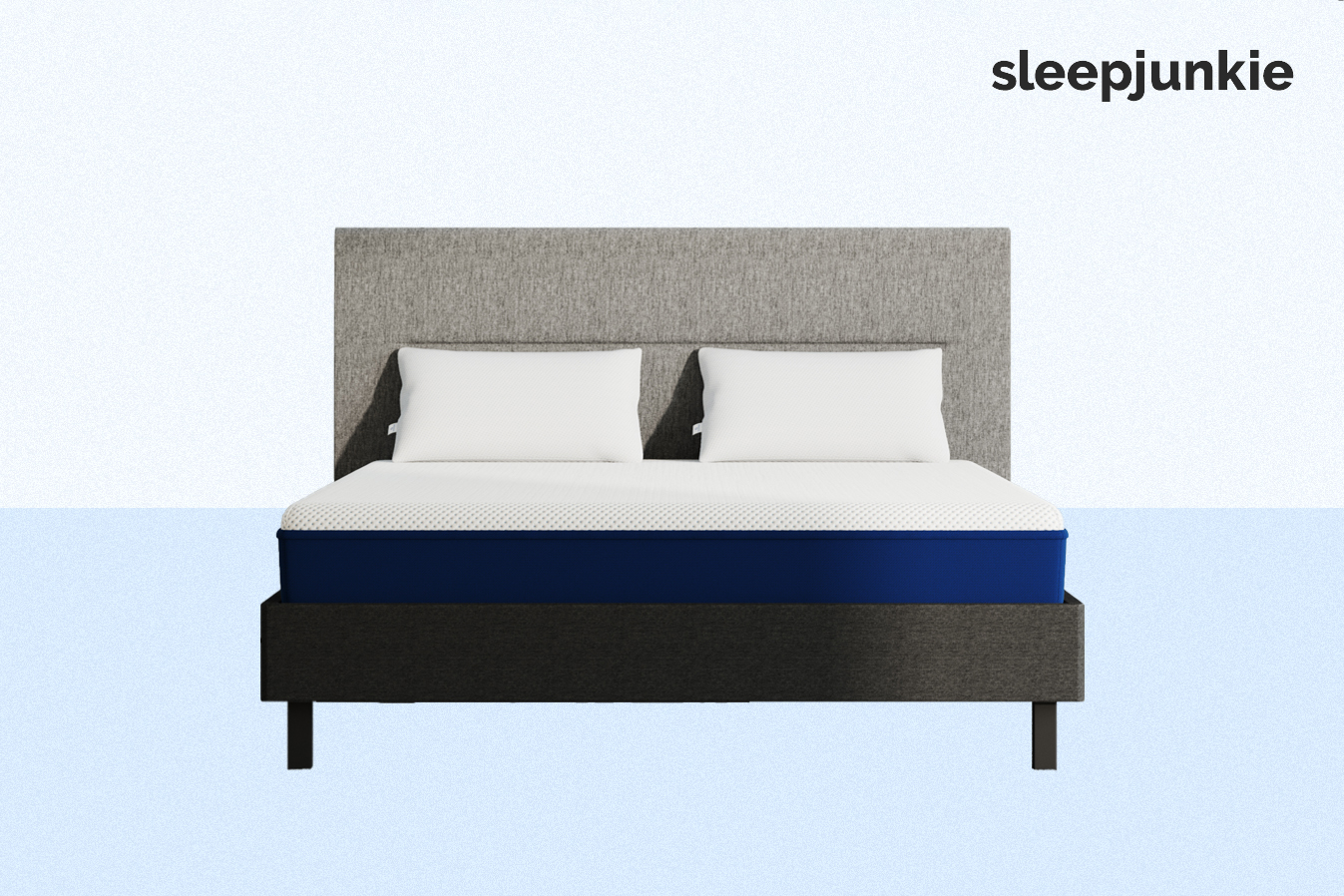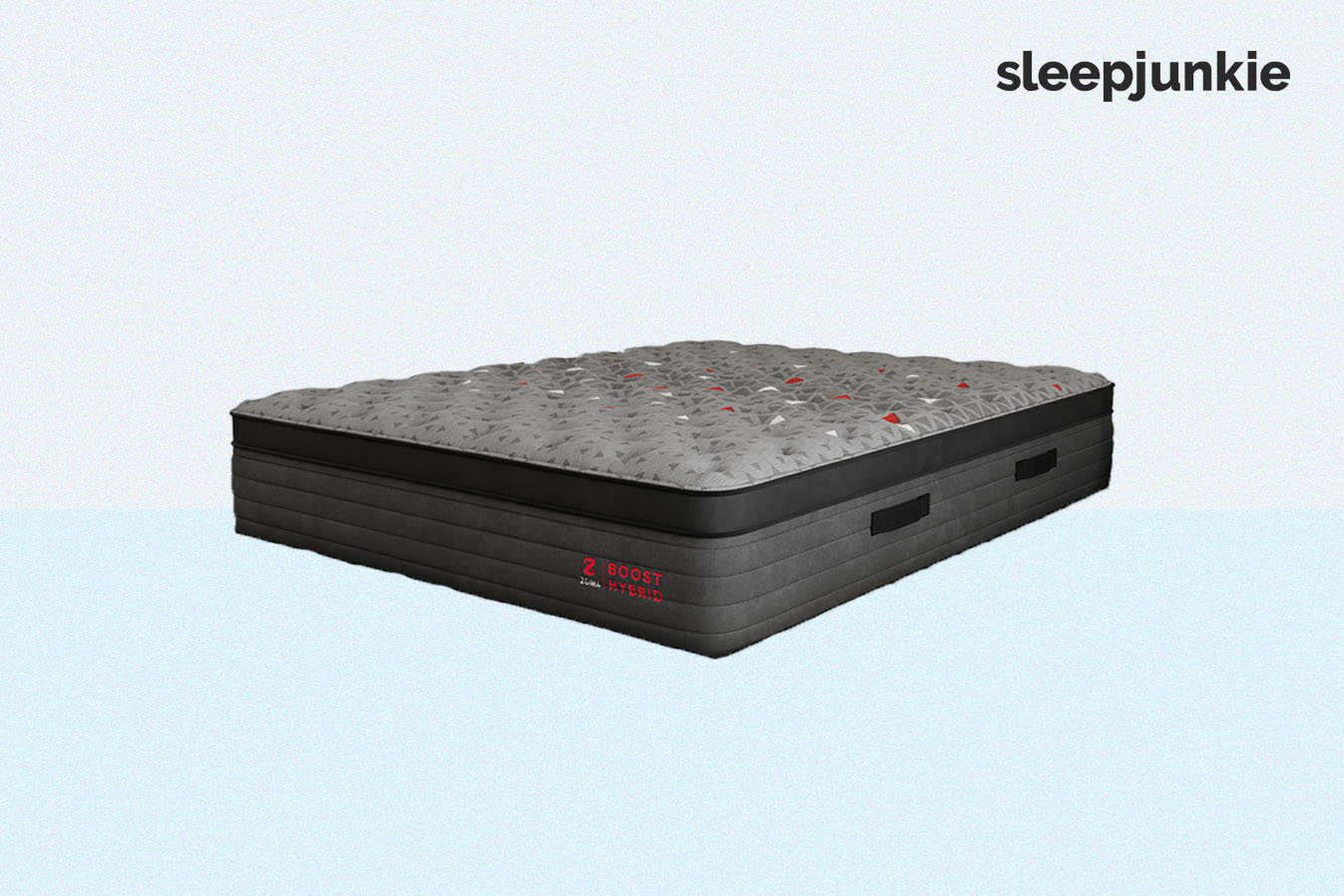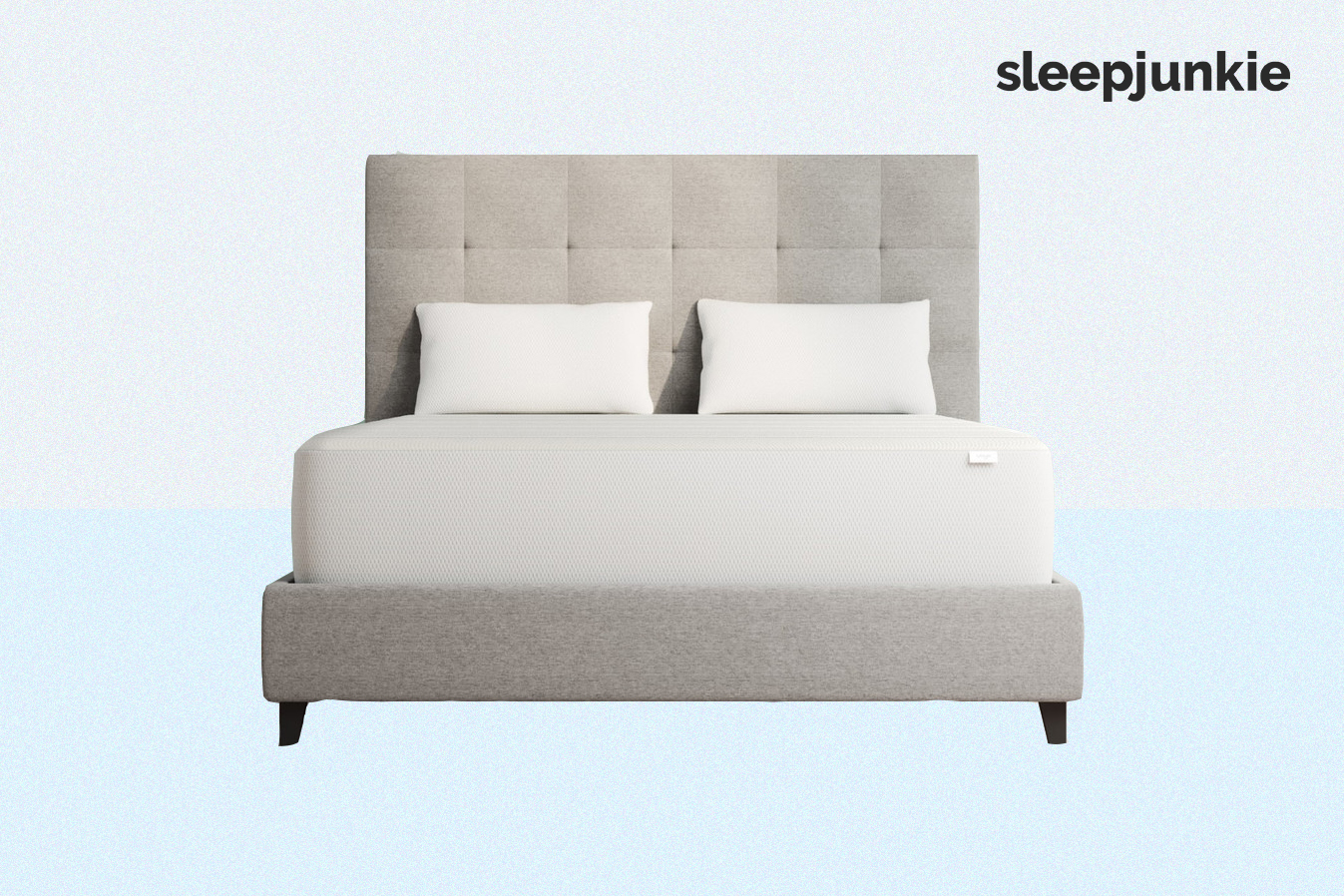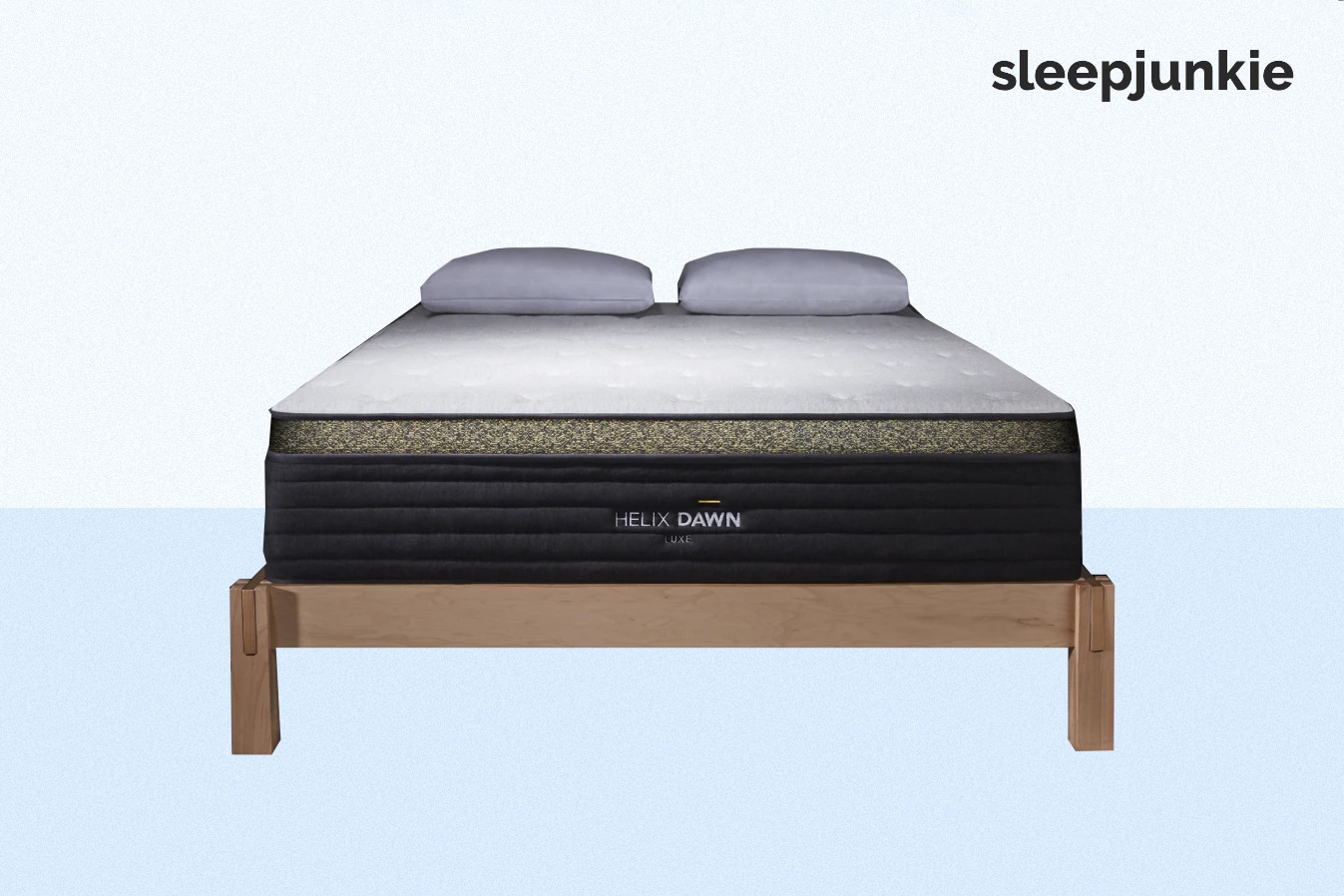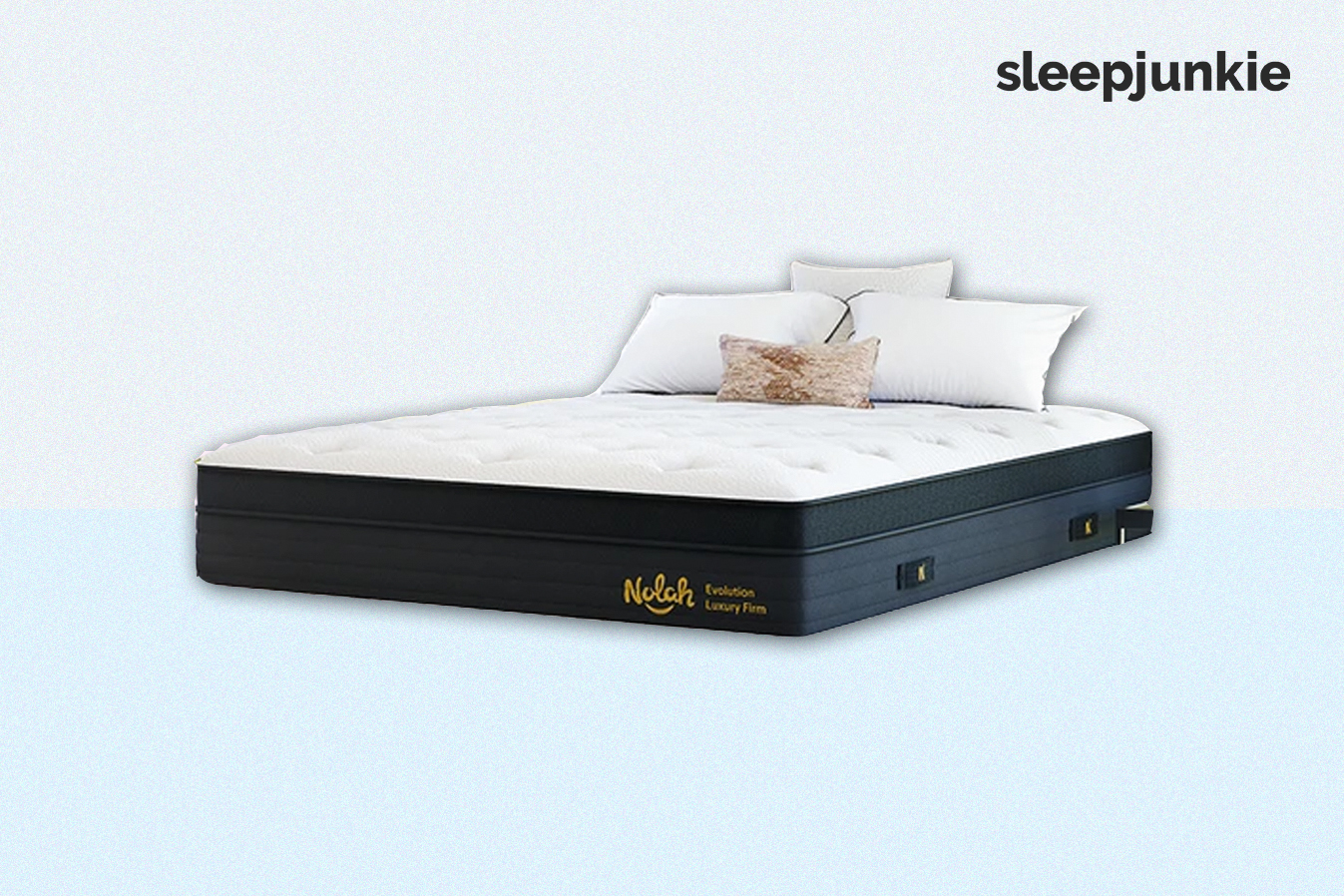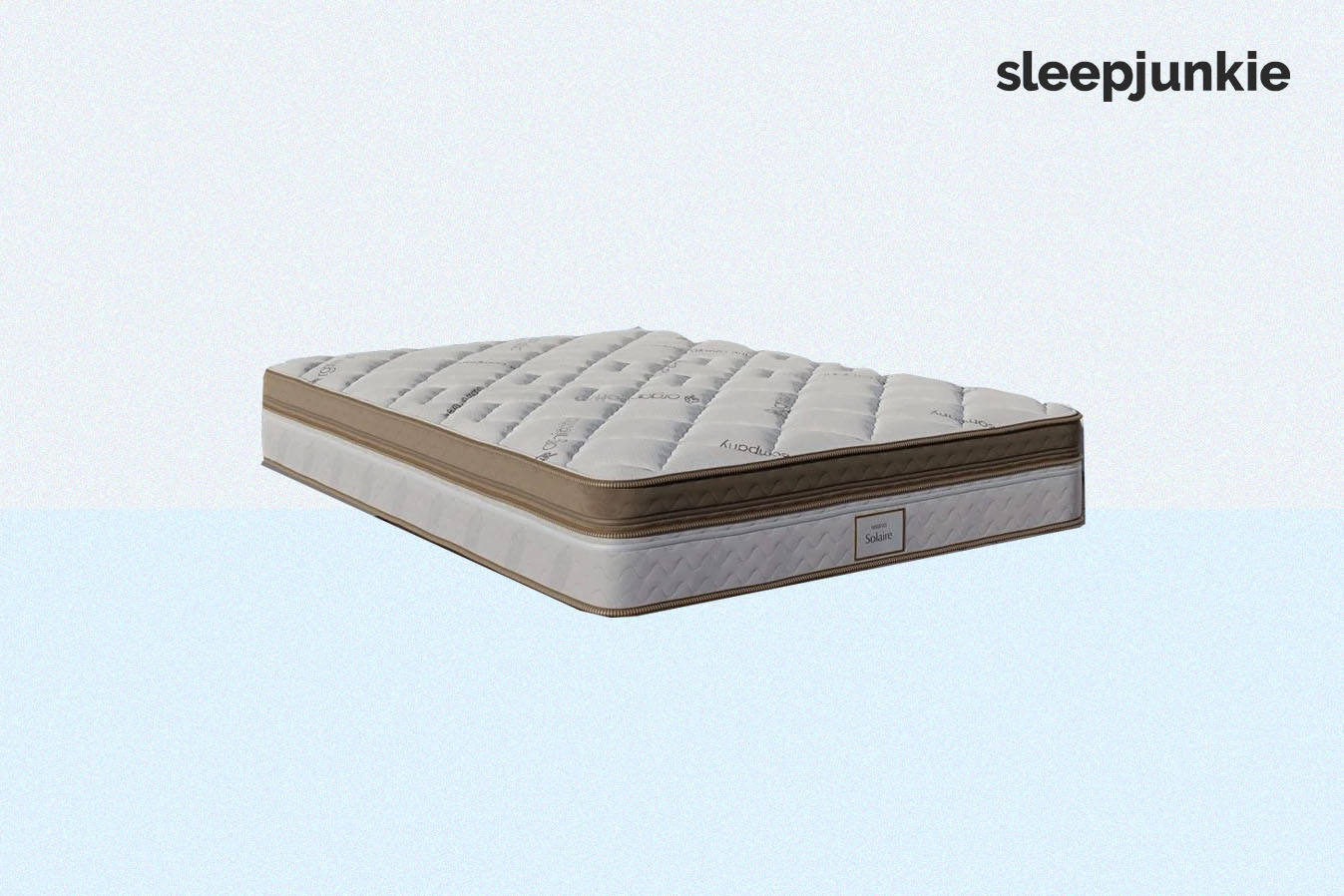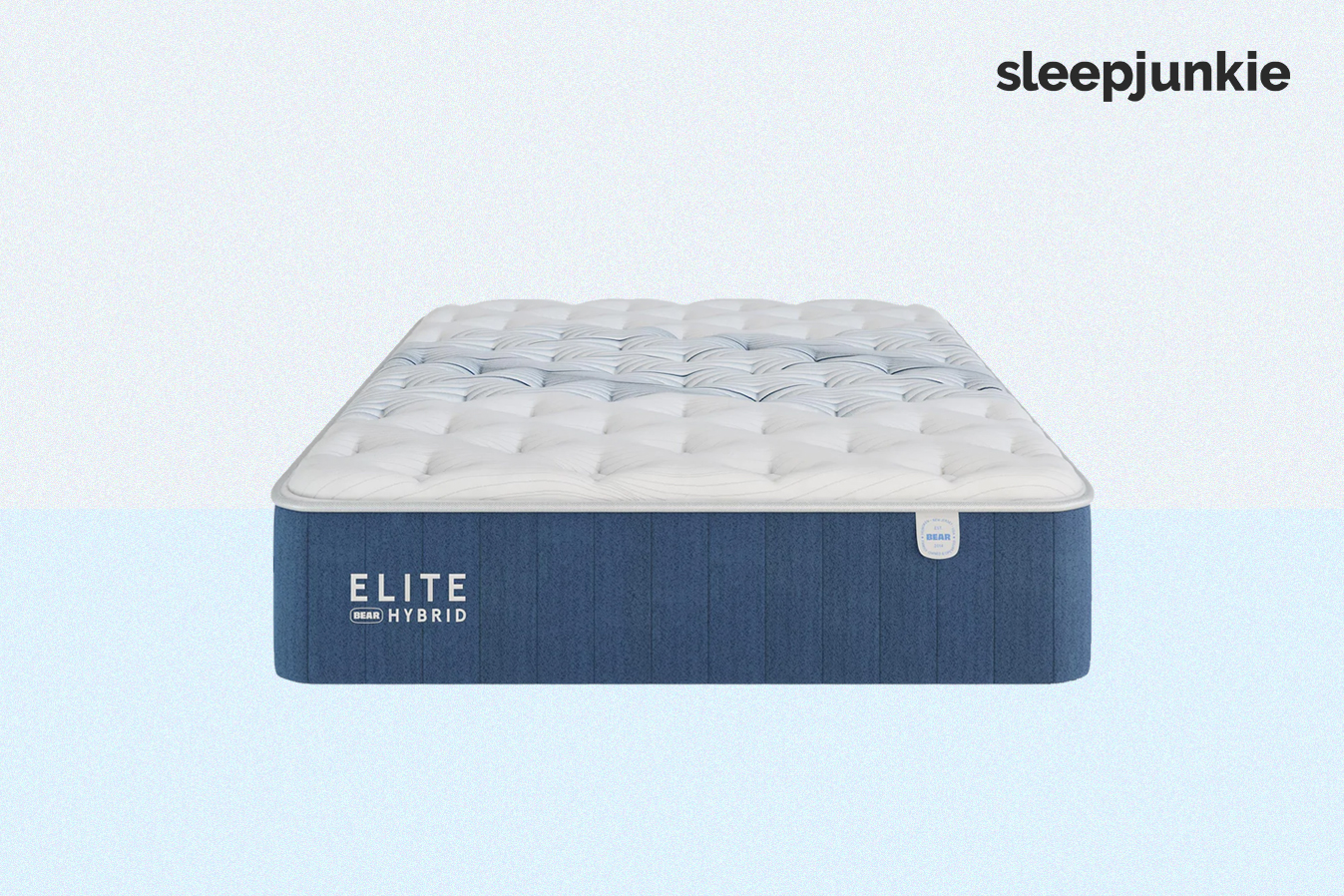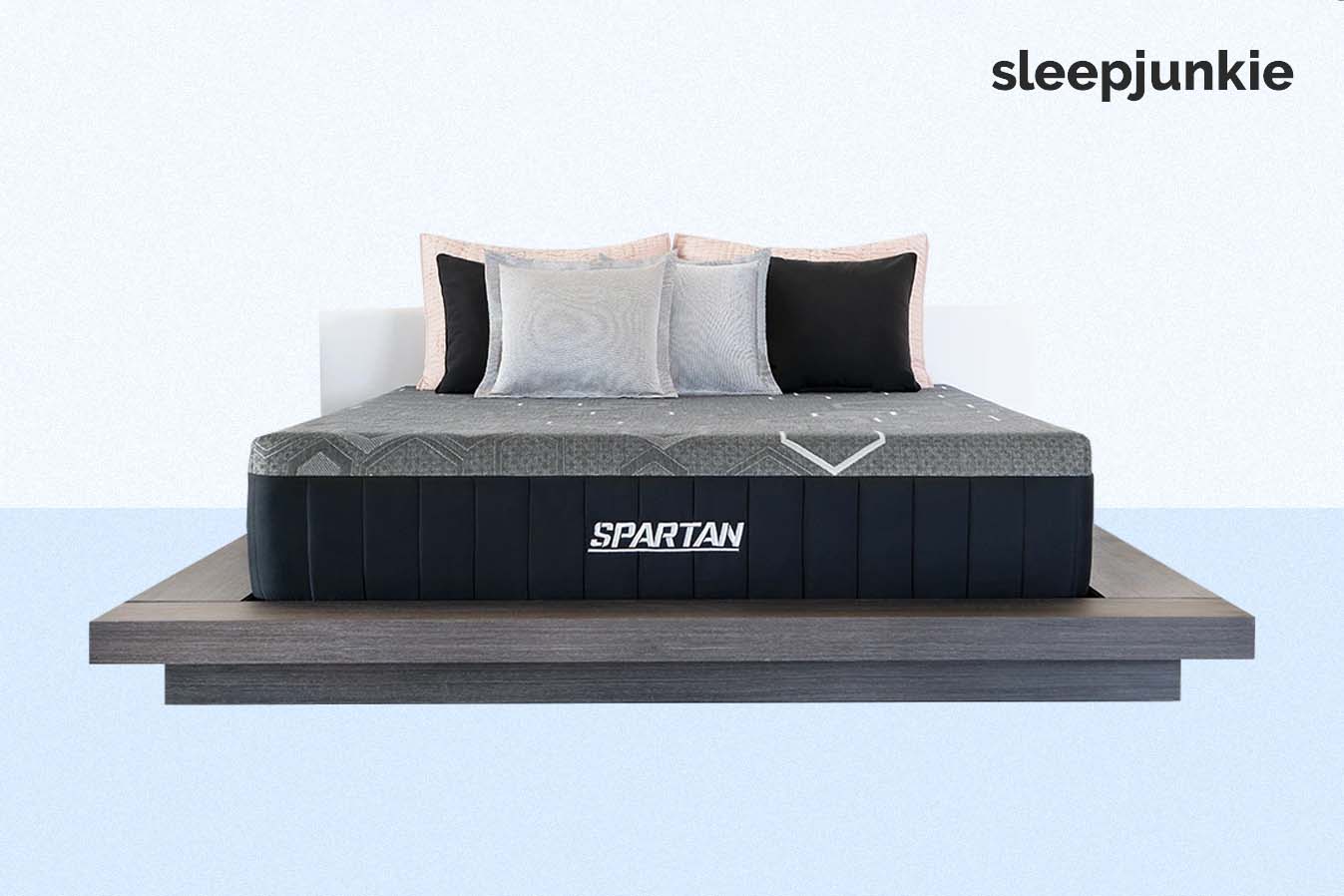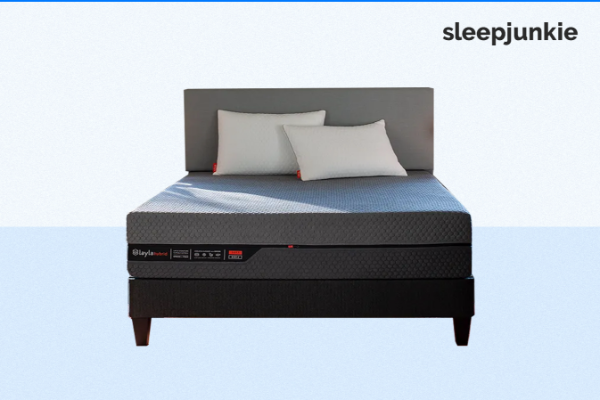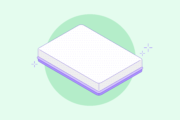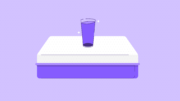Best Mattresses for Degenerative Disc Disease
Dr. Jordan Burns, DC, MS
Dr. Burns is an established authority in sleep health, combining over a decade of hands-on experience in chiropractic care with a deeply rooted knowledge of sleep science. A holder of degrees in Kinesiology, Life Sciences, Sports Science and Rehabilitation, and Chiropractic, his interdisciplinary background uniquely positions him at the intersection of wellness, ergonomics, and sleep […]

- Best Mattress for Degenerative Disc Disease Overall: Amerisleep AS2
- Best Softer Mattress for Degenerative Disc Disease: Zoma Boost
- Best Value Mattress for Degenerative Disc Disease: Vaya Hybrid
- Best Luxury Mattress for Degenerative Disc Disease: Helix Dawn Luxe
- Best Cooling Mattress for Degenerative Disc Disease: Nolah Evolution 15
- Best Customizable Mattress for Degenerative Disc Disease: Saatva Solaire
- Best Hypoallergenic Mattress for Degenerative Disc Disease: Bear Elite Hybrid
- Best Performance Mattress for Degenerative Disc Disease: Brooklyn Bedding Spartan
- Best Dual-Sided Mattress for Degenerative Disc Disease: Layla Hybrid
Degenerative disc disease is a painful condition that can often leave you with debilitating discomfort. The good news is you don’t have to treat your symptoms solely with medical intervention. An amazing mattress can help alleviate your pain by keeping your spine aligned and offering ideal support to your body.
“Degenerative disc disease (DDD) is a condition that occurs when the discs between the spinal bones (vertebrae) become damaged or worn down,” noted Dr. Jordan Burns. “The most common symptom of DDD is back pain. This can range from mild to severe and may be localized to one area or radiate throughout the back.”
“Other symptoms may include stiffness and difficulty moving, as well as numbness or tingling in the arms and legs. Finding the right mattress is imperative to helping alleviate some of these symptoms.”
Below, we’ll talk about some of the best mattresses for degenerative disc symptoms. And we’ll also discuss all the factors you should consider when deciding which mattress is best for you.
Amerisleep AS2 Overview
Among the best mattresses for degenerative disc disease on the market today, the medium-firm AS2 by Amerisleep offers tons of support and pressure relief to keep you lifted onto the sleep surface and contour to the curve of your spine for optimal spinal alignment. Best of all, this mattress is made of Amerisleep’s fantastic plant-based memory foam.
“The medium-firmness of the AS2 mattress, as well as the five zones of targeted support, make this mattress my top choice for my patients suffering from DDD,” noted Dr. Jordan Burns. “This mattress provides the proper support to keep the spine in alignment for all different sleeping styles.”
All Amerisleep mattresses come with a 100-night sleep trial and a 20-year warranty.
- Medium-Firm Feel for Back Support
Gently firm feels are usually best to prevent spine misalignment.
- Eco-Friendly Comfort Foam
While most memory foams are wholly synthetic, Amerisleep uses plant oils in theirs, along with more traditional ingredients.
- Five Zones of Targeted Support
The surface feels softer and firmer under the body as needed.
Lying down on the AS2, you’ll feel the benefits of its plant-based memory foam right away. The first thing you’ll notice is how much more breathable and cooling this mattress is without any need for infusions, gel, or any of the other trappings that normally make memory foam cooler. This is all thanks to its natural plant-based ingredients.
Comfort Layers
The AS2 starts with a comfort layer made of Bio-Pur® plant-based memory foam. This foam is what gives this mattress its cooling, breathable, and responsive feel. Instead of using all petroleum-based ingredients, Amerisleep replaces some of the petroleum oils in this foam with plant oils. This creates a huge difference in the feel of the comfort layer.
Transition Layers
Next, you’ll find the HIVE® transition layer. This layer offers targeted support to each area of your body so that you get more lift in your head, legs, and middle and more cushion underneath your shoulders and hips. This is perfect for those who need extra lumbar support and contour to ease their back pain.
Support Layers
Finally, the extremely firm and dense support foam brings up the bottom of the mattress. This Bio-Core® base foam provides maximum lift to keep your body on top of the sleep surface, and it also ensures this mattress will resist sagging and soft spot development for at least 20 years, making this one of the most durable mattresses on our list.
If you have back pain but side sleep, you may find yourself in a bit of a pinch because you need a firmer mattress to deal with your back pain and a softer mattress for side sleeping. The good news is there are mattresses out there that can offer you the right mix of support and pressure relief for both your sleep position and your back pain, and the Zoma Boost is one of them.
Zoma mattresses come with a 100-night sleep trial period and a 10-year warranty.
- Instantly Icy Comfort
Sleepers will quickly relax on the mattress’s cool surface.
- Soft Surface Hugs the Body
Plush but not too plush, the Zoma Boost is quick to relieve pressure and pain.
- Pocketed Coils Buoyant for Easy Movements
It’s a snap to move across the plush surface thanks to its coil support.
Lying down on the Boost, the first thing you’ll notice is that it has a soft and cushiony, yet supportive, feel. This is all thanks to its multiple layers of foam sitting on top of its high-tension coil layer. The coils provide sturdy and adaptable support, while the multiple layers of foam offer pressure relief.
Comfort Layers
The Boost boasts a cooling cover that breathes with your body’s movements to keep the sleep surface cool. This cover rests atop two layers of hypersoft quilt foam that give what would otherwise be a much firmer mattress its plush and medium-soft feel.
Next, a layer of graphite-infused memory foam pulls heat away from your body and deeper into the mattress where it can be dispersed. This layer also helps fight common microbes, as graphite creates a hostile environment for them.
Transition Layers
Underneath these layers sits the Reactiv™ layer. This bouncy and buoyant transition foam increases the responsiveness of this hybrid mattress.
Support Layers
The Reactiv™ layer sits directly atop a layer of pocketed coils that improve its responsiveness and provide dynamic support to the mattress.
Vaya Mattress Overview
If you are worried that a quality hybrid mattress is just out of reach of your budget, check out the Vaya Hybrid. This hybrid mattress keeps quality high and costs low by offering a simple yet comfortable design.
- Budget-Friendly, High-Quality Construction
Simple design uses exceptional materials for enduring comfort
- Cooling Comfort Materials
Cotton and airy comfort foam conform to sleepers’ bodies.
- Supportive Wrapped Coils
Individually wrapped coils isolate motion as sleepers move.
The Vaya Hybrid is another mattress on this list that is fantastic for side sleepers. This is thanks to its highly contouring memory foam and extremely adaptable pocketed coil support layer. These layers provide enough support to keep your spine aligned to relieve back pain while cradling your joints so you don’t have pain in your pressure points from sleeping on your side.
Comfort Layers
The comfort layer of the Vaya Hybrid is made of ultra-porous memory foam that features millions and millions of air pockets to keep cooling air flowing. This highly contouring memory foam also offers deep compression to keep your joints safe from pressure.
All this comfort is wrapped in a plush and breathable cover that works with the coils and foam to keep cooling air flowing through the entire mattress.
Support Layers
Underneath the comfort layer, a layer of pocketed coils offers dynamic and adaptable support because each coil can compress and rise independently. This creates a support system that can mold itself to your shape and bounce back underneath you, all without transferring motion.
And the coil support core sits on a base of high-density foam for added stability and durability. So you can expect this mattress to last just as long as its more expensive competitors.
Helix Dawn Luxe Overview
If you want a luxurious feel as well as fantastic pain relief, check out the Helix Dawn Luxe. This firm mattress offers lots of luxurious features as well as enhanced back support to keep you free from pain and well-rested. Best of all, you get a luxury feel without the luxury price tag!
- Firm Quilted Pillowtop Surface
Many pillowtop mattresses can feel too cushy under the body, but the Dawn Luxe is pleasantly firm.
- Multiple Cooling Materials
Sleepers can even customize the cover fabric for more coolness.
- Zoned Pocketed Coil Support
Coils are arranged for extra back support under the body.
The Dawn Luxe is a truly firm mattress. This means it offers tons of lift to stomach and heavier sleepers with back pain. At the same time, its luxurious foam layers and zoned coils ensure that this mattress will not exert too much pressure where you don’t need it. They also ensure you can enjoy a luxurious feel while maintaining high support.
Comfort Layers
The Dawn Luxe starts off with a choice of cooling cover. You can choose between breathable and moisture-wicking TENCEL or thermally conductive GlacioTex fabric. Whichever cover you choose, it will sit on top of a premium cooling pillow top that draws heat away from your body and adds cushioning to this firm mattress.
Next, a firm layer of high-grade polyfoam offers lots of support and just enough contour to ensure your pressure points stay pain-free. This layer rests atop a layer of Helix Dynamic Foam that offers a firm and responsive feel, as well as gentle contour.
Transition Layers
The transition layer of the mattress is also made of high-grade polyfoam, sandwiching the comfort layer between two layers of this material.
Support Layers
Finally, a layer of zoned coils provides support for this mattress. These zoned coils provide enhanced lumbar support and edge support by running reinforced coils through the center and around the perimeter. This has the added advantage of not impeding airflow through the bottom of the mattress, as foam rails tend to do.
Nolah Evolution 15 Overview
For hot sleepers who have back pain, finding a mattress that can offer both cooling and lumbar support can feel like a hassle. The good news is the Nolah Evolution 15 offers plenty of both.
Nolah mattresses ship free and come with a 120-night trial period and a lifetime warranty. For extra savings, you can remove the trial period at checkout.
- Highly Advanced Cooling Design
Graphite infusions, cooling foams, and airy fabrics ensure comfort.
- Natural Fibers and Foundation
Cover has organic cotton fibers and the coils rest on recycled plant fibers.
- Three Zones of Targeted Support
Mattress feels firmer under the back and softer in the head and foot of the bed.
The main thing you will notice when you lie down on the Evolution is just how cool it actually is. This mattress combines multiple cooling technologies that enhance both breathability and thermal conductivity for an amazing cool-touch feel.
Comfort Layers
The first layer of this mattress is an ultra-cooling and breathable cover that sits at the top of a premium HTC quilted Euro top that draws heat away from your body. This heat winds up at the heat escape gusset that runs around the perimeter of the mattress to let heat out of it.
Any heat that doesn’t escape the gusset will run into the graphite-infused memory foam comfort layer. This layer draws residual body heat away from you to ensure that the sleep surface doesn’t just start out cool to the touch but stays that way throughout the night.
Transition Layers
This comfort layer sits on top of two layers of high-density and high-resilience foam.
Support Layers
Then, a layer of zoned coils offers reinforced support around the perimeter and through the middle. This means this mattress has enhanced lumbar and edge support no matter what firmness you choose.
Saatva Solaire Overview
If you want a mattress that can change its firmness at the touch of a button, say hello to the Saatva Solaire. This mattress offers 50 precise firmness settings that can adjust based on your pain level, support needs, and even your mood! All you have to do is press a button.
- Dozens of Adjustable Firmnesses
Easy to customize the bed’s feel with the touch of a button.
- In-Room Setup Included
No need to worry about setting up your new mattress yourself.
- Breathable, Hypoallergenic Organic Cotton
The mattress surface ensures cool, clean sleep.
The Solaire doesn’t have a single feel because you can make it feel any way you want. Thanks to its vulcanized air chamber support core, the Solaire can go from ultra-firm to ultra-soft in a matter of seconds, and it can offer every firmness level in between!
Comfort Layers
The first layer of the Solaire is the breathable organic cotton cover. This cover is infused with botanical antimicrobial treatments to prevent bacterial and mold growth. This can help keep you allergy-free.
Next, a contouring three-inch Euro top provides lots of pressure relief, while the comfort layer of natural latex offers buoyant and pressure-free support.
Transition Layers
This five-zone comfort layer sits atop a layer of gel memory foam to enhance contour and draw body heat away from you.
Support Layers
Finally, we get to the vulcanized air chamber support core. These air chambers can pull in more air to firm up or release air to grow softer. This is how the mattress is able to switch its firmness so easily. These air chambers sit atop a reinforced power edge enclosure to provide a stable base and clutter-free performance. They’re also inside a moisture barrier for added protection.
Bear Elite Hybrid Overview
If you have allergies and back pain at the same time, check out the Bear Elite Hybrid. This mattress offers lots of lumbar support and creates a hostile environment for most common allergens at the same time.
You have 120 nights to try out the Bear Elite Hybrid, along with a lifetime warranty.
- Antimicrobial Copper Infusion
Copper naturally repels microbes that can settle and cause a stink in the mattress.
Cool to the Touch Surface
Phase change technology and thermoreactive minerals keep the bed cool
Responsive Transition Foam and Coils
Hybrid delivers bouncy comfort underneath the body.
The Elite uses copper infusions to create an unwelcoming environment for all kinds of microbes that can cause allergens. Not only is copper a wonderful antimicrobial substance, but it is also highly thermally conductive, which means it is extremely cooling. This means the first thing you’ll notice when you lie down on the Elite is that it has a very cool sleep surface.
Comfort Layers
The first layer of the Elite is it copper gel memory foam comfort layer. This is the layer that draws heat away from your body, and it’s also the layer that keeps you cool while you sleep. It works with the highly breathable cover to both draw heat away from you and keep cool air flowing.
Transition Layers
Underneath the copper memory foam, you’ll find a layer of dynamic transition foam. This transition foam offers ergonomic support and provide seamless progression to the coils below.
The Elite’s pocketed coil support layer works with your body to keep your spine aligned and offer pressure relief at the same time. This is thanks to its unique system of coils that are reinforced through the middle and around the perimeter. The reinforced coils offer extra lumbar and edge support, while the softer coils provide pressure relief to the areas that need it.
Brooklyn Bedding Spartan Overview
Those who want tons of contouring and support all at once should check out the Spartan by Brooklyn Bedding. This hybrid mattress pulls out all the stops to ensure you get the best hybrid support.
- High-Recovery Design
Like many mattresses for athletes and active people, the Spartan promotes maximum recovery during rest.
- FIR Tech and Cooling Infusions
Mattress surface materials pull away excess heat.
- Choice of Three Firmnesses
Mattress comes in three distinct firmnesses to suit different styles.
The Spartan comes in three firmness levels, but those who need extra support should choose the firm option. This option provides all the support you need to feel comfortable all night.
Comfort Layers
The Spartan starts off with a CopperFlex™ comfort layer. This layer offers a water-based surface infusion for high thermal conductivity to draw your body heat away from you. This layer sits on top of a layer of firm premium memory foam. This foam provides a second layer of support.
Transition Layers
Next, a layer of VariFlex™ transition foam offers seamless progression to the coil layer of the mattress. In the soft and medium versions, this layer is substituted with a layer of gel swirl memory foam.
Support Layers
Finally, a layer of zoned Ascension™ coils delivers the ideal support to each area of your body to keep you lifted and your spine aligned.
Layla Hybrid Overview
Those who want options when it comes to firmness should check out the Layla Hybrid. This flippable mattress is a firm and a soft bed all in one!
- Two-In-One Mattress
Torn between soft and firm feels? You can have both with the Layla Hybrid!
Comfortable Copper Infusions
Copper infusions ensures a cool, clean mattress surface.
- Supportive Foams and Pocketed Coils
Both sides feature pressure-relieving foams and a base of wrapped coils.
Lying down on the Layla depends on which side you lay it on. The soft side is medium-soft, meaning it’s perfect for side sleepers. The firm side is a true firm, which makes it perfect for stomach sleepers.
Comfort Layers
Starting with the soft side, the Layla Hybrid features a layer of copper-gel memory foam that draws body heat away from you.
Transition Layers
This heat gets pushed into the Max Airflow foam underneath, where it can be pushed out of the mattress by the cooling air circulation.
Support Layers
The core of the mattress is made of zoned coils that provide more support in the center and more pressure relief on the ends. This layer also features a double coil perimeter for enhanced edge support.
The Layla features mirrored construction. This means the support core sits in the middle between the comfort and transition layers. The firm side features a layer of Max Airflow and copper memory foam as well.
How to Choose the Best Mattress for Degenerative Disc Disease
Of course, when you’re choosing a mattress to help with your back pain, you should focus on that issue. However, you cannot ignore other factors when you are considering mattresses.
If you only focus on your back pain without considering anything else, you could cause yourself other problems even if you solve the back pain itself. This is why you want to get a mattress that’s perfect for all your sleep needs.
What is Degenerative Disc Disease?
Everyone has rubbery cushions between the bones of their spine. When these rubbery cushions, or discs, start to wear away, you develop degenerative disc disease 1 Verified Source Johns Hopkins Medicine University focused on medical research that produces thoroughly reviewed health articles. See the source . Most adults over 40 will experience some amount of disc degeneration over time 2 Verified Source Cleveland Clinic Ranked #2 hospital by U.S. News & World Report and one of the largest academic medical centers in America. The Cleveland Clinic serves patients from all over the world. See the source .
This can be so mild that you don’t experience any symptoms at all or so severe that you experience debilitating pain and weakness or even a herniated disc 3 Verified Source Medline Plus Online resource offered by the National Library of Medicine and part of the National Institutes of Health. See the source .
Symptoms of degenerative disc disease 4 Verified Source Medline Plus Online resource offered by the National Library of Medicine and part of the National Institutes of Health. See the source can include back pain, numbness and tingling in the arms and legs, and pain that radiates down your hip or leg and gets worse when you are sitting or bending. There are some medical treatments that can help ease the symptoms of degenerative disc disease, but there is no cure.
Taking pressure off the spine is one of the best ways to help ease the symptoms of this illness. This means getting a fantastic mattress and possibly even an adjustable bed can be one of the best ways to take care of yourself when you have this condition. Many of the most comfortable mattresses on the market work well with adjustable beds, after all, to further improve comfort.
How Can My Bed Help Ease My Symptoms?
Your bed can ease your symptoms by helping to keep your spine properly aligned. This takes the pressure off the discs and the nerves inside your spinal column. Your mattress itself will do the bulk of this work.
When you lie down on your new mattress, it should mold itself to the shape of your back, following the curve of your spine to ensure it stays properly aligned. With one of the best mattresses, the spine should always be in a horizontal line while you sleep to maintain optimal pressure relief for your back.
The mattress isn’t the only part of your bed that can help ease your back pain. An adjustable bed can also go a long way toward easing your degenerative disc symptoms. Sleeping on an adjustable bed allows you to get into positions that put less pressure on your spine than lying flat. Lying flat is actually a lot harder on your back than sitting up.
The best position for sleeping when you have back pain is the zero gravity position. In this position, you place your legs and your head above your heart. This aligns your spine and takes pressure off of your vertebral column.
While you can achieve this position without an adjustable bed, an adjustable bed for back pain is much easier and more efficient than piling up a bunch of pillows. And with modern day adjustable beds, you don’t even have to pay all that much more than you would for a regular bed frame.
Gone are the days when hospital beds that cost thousands of dollars were your only option. Nowadays there are highly affordable and advanced adjustable beds for seniors and others with degenerative disc disease.
Ideal Mattress Materials for Degenerative Disc Disease
The best mattress materials for degenerative disc disease are the ones that can offer contoured support. Mattress types that can lift you onto the sleep surface and take the shape of your spine offer the best support to relieve your back pain. Some materials are better than others when it comes to contoured support.
Memory Foam
Memory foam mattresses can be a wonderful option for degenerative disc disease sufferers. This special type of flexible polyurethane foam contours to your body in a way that no other material can. Memory foam is extremely flexible. It can mold itself to your body by altering its shape to fit yours. This can help keep your spine aligned without sacrificing pressure relief.
Memory foam is potentially the best solution for degenerative disc disease sufferers who sleep on their sides. Sleeping on your side causes you to need a softer mattress with lots of pressure relief, while back pain typically means you need a firmer mattress for extra support.
This can leave side sleepers in a difficult conundrum because they need the lift of a firmer mattress and the pressure relief of a softer one. Memory foam’s contouring ability can help solve this problem because firmer memory foam mattresses can still offer side sleepers plenty of contouring and lift at the same time. Memory foam is often essential in the best mattresses for pressure points.
The people who need to watch out for memory foam are hot sleepers and active sleepers. Memory foam mattresses tend to retain more heat than other mattress types. This can mean hot sleepers may have a hard time sleeping on traditional memory foam, though gel memory foam can help with this issue.
The issue gel memory foam cannot help with is memory foam’s slow response time. Memory foam tends to bounce back slower than any other mattress material. This can leave active sleepers feeling annoyed as they have to wait for body impressions to clear. This means if you like to toss and turn, a pure memory foam mattress might not be for you.
SEE ALSO: Memory Foam Mattress Buying Guide
Latex Foam
Natural latex is the perfect alternative to memory foam for certain types of sleepers. For hot sleepers, the natural breathability of latex mattresses can help keep the sleep surface cool.
For active sleepers, latex’s natural responsiveness offers much more bounce than memory foam ever can. This means hot sleepers and active sleepers who want an all-foam mattress can consider buoyant and springy natural latex foam.
Natural latex foam can be one of the best solutions for degenerative disc back pain because latex offers tons of buoyant support. Those who need additional contouring, such as side sleepers, should consider Talalay latex.
Talalay is the lighter and more flexible version of latex foam. Those who need extra support should consider Dunlop latex, which is the more buoyant and denser version.
Another wonderful thing about latex is its eco-friendliness. Latex is a natural material, meaning it does not produce as much toxic waste in the manufacturing process as memory foam.
Latex is also recyclable and biodegradable, meaning it will not sit around a landfill for a thousand years after you throw your mattress out. Best of all, the fact that latex is a natural material makes it more durable than any other mattress type. Expect your latex mattress to last for decades.
The main thing that degenerative disc sufferers have to worry about is latex’s tendency to retain its shape. Natural latex is not as flexible as memory foam and gets its buoyancy and bounciness from its desire to maintain its own shade. This means that for all the benefits of a latex mattress, it is not as contouring as memory foam. Many sleepers will not notice the difference, but side sleepers with back pain problems might.
SEE ALSO: Latex Mattress Buying Guide
Hybrid
Hybrid mattresses might just be the single best solution for every kind of sleeper who suffers from degenerative disc disease. Hybrids combine a support core of pocketed coils with a comfort layer of either memory foam or latex foam. There may also be other foam transition layers in a hybrid mattress.
This combination of coils and foams offers the best of both spring and foam mattresses all at once. This is not just because hybrid mattresses have foam but also because they feature pocketed coils. Pocketed coils are individually wrapped in a foam or fabric casing. This gives them multiple advantages over open coils and base foams alike.
The fact that they’re individually wrapped means that pocketed coils can move independently of one another. This makes them the most flexible support layer option available. Pocketed coils aren’t just the best at adapting to your shape. They also offer tons of support. They isolate motion. And they bounce back underneath you for fantastic responsiveness.
Pocketed coils also circulate air much better than base foam. This keeps cooling air circulating underneath your comfort layer. If you add latex foam or gel memory foam on top of this, you can get the coolest sleep surface available.
Just be aware that hybrid mattresses are not as durable as all-foam construction because the coils inside them lose tension and break down. If you combine this decreased durability with the fact that hybrid mattresses are almost as expensive as latex ones, on average, you get the most expensive mattress type overall. This can be prohibitive for some shoppers, although it is possible to find quality budget hybrid mattresses.
SEE ALSO: Hybrid Mattress Buying Guide
Innerspring
Innerspring mattresses are the worst mattress type for back pain sufferers, including people with degenerative disc disease. These mattresses have internal support cores made of open coils. Unlike pocketed coils, open coils are not encased and are wired together with steel cables. This creates a network of coils supporting the mattress.
There are many problems that can stem from having networked coils. Potentially the biggest problem for degenerative disc sufferers is the fact that open coils do not contour very well. They tend to sag under your heavier parts instead of taking on your shape. This can leave you with spinal misalignment and actually exacerbate your symptoms rather than alleviate them.
The other main problem with innerspring mattresses is that their open coils make them incompatible with adjustable beds. All other major mattress types are compatible with adjustable bases because they can flex with the bed when it moves. Innerspring mattresses are too stiff and rigid to do this, thanks to their coil systems.
They will float over the adjustable bed and can even break when it moves from the flat position. This can be a huge problem for degenerative disc sufferers because many of them use adjustable bases to help ease their symptoms.
Another major problem with open coils is their lack of durability. Open coils are even less durable than pocketed ones. Where pocketed coils will last up to two decades, you can expect most innerspring mattresses to fail within 10 years.
This means that you will be replacing these mattresses more often than any other mattress type. For all of these reasons, we suggest hybrid mattresses for those who want coil support cores.
SEE ALSO: Innerspring Mattress Buying Guide
Ideal Mattress Firmness for Degenerative Disc Disease
When it comes to back pain, common sense might seem to dictate that the softer the mattress, the more pain-relieving it is. However, this is not the case. Typically, the best mattress firmness for those who suffer from back pain is a medium-firm mattress. This firmness level offers the right balance of support and contouring to align the spine and keep the body lifted on top of the bed.
Even so, there are other factors you need to consider when choosing a mattress firmness besides your back pain. You’ll also want to keep your sleeping position in mind and, depending on your weight, possibly your body type as well.
Sleep Position
Your sleep position is the main factor that decides how firm a mattress you need. Your sleep position dictates how your body contacts the bed, where your pressure points are, and how much support and pressure relief you need. This means you should decide your firmness baseline based on your sleep position, and only go up and down from there based on your body weight.
Back Sleepers
Degenerative disc sufferers who sleep on their backs will have the easiest time picking a mattress firmness because back sleepers typically need the firmness level that is coincidentally the best for back pain: medium-firm (6 of 10).
When you sleep on your back, you need a mattress for back sleeping that can follow the curve of your spine while still preventing you from sinking into the sleep surface. Medium-firm mattresses offer the best balance of lift and cradling to offer contoured support to back sleepers.
Combo Sleepers
Combination sleepers do not have a strong preference for any single sleep position. They may adopt any position at any point during the night. This means they need a mattress for combination sleeping that can offer plenty of versatility to support them when they’re on their backs and stomachs and cushion them when they’re on their sides.
Medium mattresses (5 of 10) typically offer the most versatility because they offer an even balance of pressure relief and support. This makes them the ideal firmness for most combination sleepers.
Side Sleepers
Side sleepers normally need softer mattresses because they need the most pressure relief. This can make finding a mattress particularly difficult for side sleepers with back pain. Generally speaking, if you sleep on your side and have back pain, you want to go as firm as possible in a mattress for side sleeping without sacrificing the pressure relief your joints need.
Medium-soft mattresses (4 of 10) are often best for side sleepers, though side sleepers with back pain may want to go up to a medium if their joints can handle it.
Stomach Sleepers
Stomach sleepers typically need the firmest mattresses (7 of 10). This is because sleeping on your stomach allows your pelvis to sink into the bed. This overarches the spine and can lead to back pain. Sleeping on a firm mattress can help counter the sinkage and prevent back pain.
However, while you can choose the best mattress for stomach sleeping if that’s what you find comfy, sleeping on your stomach is the most unhealthy position for your spine. So if you suffer from degenerative disc disease, you might want to consider trying to train yourself to sleep on your side or your back.
Body Type
If you fall inside the mattress industry’s definition of the average human weight range (130 to 230 pounds), feel free to skip ahead because your body type does not impact your firmness needs. On the other hand, if you fall outside this weight range, you may need to take that into consideration when choosing a mattress firmness.
Petite Sleepers
Those who weigh less than 130 pounds are considered petite sleepers. Petite sleepers often have trouble getting sufficient contouring and cradling out of their mattresses. One way to solve this problem is to go down a firmness level from the one that corresponds to the sleep position. This ensures a mattress for lightweight sleepers offers plenty of needed cushion.
For instance, a petite stomach sleeper might want to go down from a firm mattress to a medium-firm one to get sufficient contouring.
Plus-Size Sleepers
Plus-size sleepers weigh more than 230 pounds. If this describes you, you may need to do the opposite of a petite sleeper and go up a firmness level from the one that matches your sleep position. This is because heavier sleepers tend to get insufficient support from their mattresses.
Going up a firmness level can help solve this problem by offering you the same amount of support that an average-weight sleeper would get from a mattress that matched their sleep position. Many mattresses for heavy people offer reinforced support as an extra precaution.
FAQs
Can an adjustable bed help my degenerative disc disease?
An adjustable bed can be a wonderful option for all sorts of back pain, including pain caused by degenerative disc disease. Adjustable bases help you sleep in positions that put less stress on your body than lying flat. This can help ease all sorts of pain, even beyond back pain.
Potentially the best sleep position for degenerative disc disease is the zero gravity position. In the zero gravity post, you adjust your bed so that your head and legs are lifted above your heart. When set up on an adjustable bed for back pain, this puts your spine in a more naturally aligned position and takes the pressure off of your back and joints. This can tremendously help back pain.
While you can achieve the zero gravity position by piling up pillows on your bed, adjustable beds allow you to get into this position without a lot of effort. This can be hugely helpful for people who have mobility issues that prevent them from adjusting pillows. It can also help people whose mobility problems prevent them from getting in and out of bed.
What is the best firmness if I have degenerative disc disease?
The best firmness level for just about all back pain sufferers is medium-firm (6 of 10). Medium-firm mattresses offer a balance of support and pressure relief that slightly favors support. This is the best option to keep your spine aligned and help prevent back pain.
Keep in mind, however, that your back pain is not the only factor that impacts your firmness needs. Your sleep position and body type also have an impact on how firm your ideal mattress should be. For example, side sleepers with back pain will likely experience joint pain if they get a medium-firm mattress because the mattress will not offer enough pressure relief.
This means you will need to take your weight and especially your sleep position into account when selecting a mattress firmness. If you fail to do so, your back pain relief could come at the expense of other problems.
Should I get a mattress topper for my degenerative disc disease?
Mattress toppers can sometimes help with degenerative disc problems, but only if your mattress is too firm. Mattress firmness comes from its support core and not the layers on top. This means if your mattress is too soft for you, the best thing you can do is replace it.
However, if your mattress is overly firm and causing you back pain or exacerbating your degenerative disc symptoms, a mattress topper for back pain can help by adding contouring that can keep your spine better aligned.
Which mattress material is best for degenerative disc disease?
There are several mattress materials that can be a great fit for degenerative disc disease, but the best ones are latex foam and hybrids. Latex mattresses and hybrid mattresses both offer buoyant support and tons of contouring to ensure your spine is ideally aligned to relieve the most pain.
Degenerative disc disease sufferers who want tons of durability and eco-friendliness should check out latex. This natural material will last far longer than any other mattress type and produces much less toxic waste to manufacture. It’s also recyclable and biodegradable to boot.
Hybrid mattresses offer a bit more bounce and a little more affordability than latex. But they are not as durable and not as eco-friendly. However, pocketed coils are the most contouring of all support core materials, which means they offer the most customizable support. This can be hugely helpful to those who suffer from back pain of all types.
How much should I pay for a mattress for degenerative disc disease?
How much you pay for a mattress depends on a lot of different factors. But since there are not really any mattresses that are specifically designed for degenerative disc disease, the fact that you’re buying it for that should not have any impact on its price.
This means you can expect to pay on average anywhere from a few hundred to several thousand dollars for a mattress. Memory foam mattresses are typically the most affordable, while latex mattresses have the highest upfront cost of any mattress type.
Don’t let this fool you into thinking that latex is the most expensive material. Hybrid mattresses may cost less than latex up front, but since you are going to be replacing them more often, you will be paying the most for a hybrid mattress over the course of its lifetime.
Bottom Line
Degenerative disc disease can disrupt your whole life, but choosing the right mattress can help put you back on track. Just remember that you shouldn’t focus only on your back pain when choosing a mattress’s firmness and material. You’ll also need to consider other factors, like your sleep position and sleep temperature, when selecting the perfect mattress for you.

